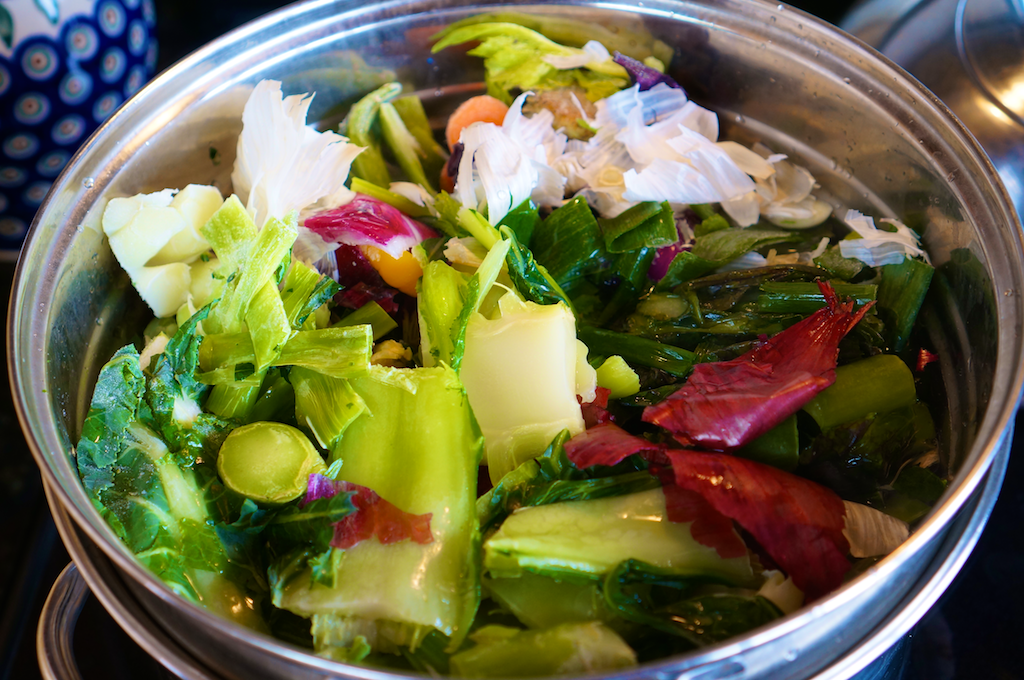I had the pleasure of teaching a class on making homemade herbal soup stocks at the Herbstalk Wintergreen Market this past weekend (here are some fun photos from the event!). I loved teaching this class because making my own stocks and broths is seriously one of my favorite kitchen activities. There is something so meditative about saving scraps over time and then turning them into wildly nourishing foods. So, if you’re looking to hop on the homemade broth bandwagon, here is everything you need to know to get started!
As the weather cools it becomes increasingly important to fuel our bodies with nutrient-rich, warming foods. Homemade soup stocks and broths can be the cornerstone of a healthy and delicious winter wellness routine. They make wonderfully flavorful and nutritive soups (obviously), but can also be used instead of water whenever you’re cooking grains, beans, or legumes, as well as being sipped straight from a mug.
I love so much about homemade broths, including their immense versatility. You can make them from nearly anything you have in the kitchen and there are endless possible combinations. I’ve included a few of my favorite ingredients (for both flavor and health) here, but please experiment based on what you have on hand.
I begin with a mixture of vegetable scraps. I collect them while cooking, store them in the freezer, and use them as the base of my broth. You can use nearly any veggie scraps (although I’d stay away from avocado skins and cucumbers), but here are some ideas to get you started. I also add culinary and medicinal herbs to my stocks to make them extra potent.
Vegetable Ingredients
Stems from kale, peppers, broccoli, cauliflower, cabbage, parsley, cilantro, basil, tomatoes, mushrooms
Skins from onions, garlic, ginger, celery root
Tops from beets, carrots, turnips, radishes
Anything that seems to be passed its prime, but hasn’t gotten moldy
Seeds from squash
Rinds from lemons and limes
Herbal Ingredients
Astragalus – immune stimulant
Shitake or Maitake Mushrooms – immune stimulant
Kombu or Dulse – mineral rich seaweed
Thyme – anti-bacterial and supports the respiratory system
Rosemary – nourishes nervous system and supports the mind
Sage – lymphatic mover and anti-inflammatory
Bay Leaves – supports digestion
Oregano – anti-viral, anti-microbial, and anti-fungal
Turmeric – anti-inflammatory and liver detoxifier
Ginger – anti-bacterial and supports the digestive system
Chili Peppers – warming and circulatory stimulant
Black Pepper – warming and supports digestive system
Cinnamon – warming and circulatory stimulant
Other Ingredients
Add 1/4 cup cider vinegar to the pot to help extract the vitamins and minerals from the ingredients.
Directions
- Fill a stockpot ¾ full with your veggies and herbs
- Cover the veggies with water
- Bring to a boil and then simmer for 2+ hours on low heat
- Strain the broth and let it cool
- Use right away, store in the fridge (for a week) or freeze
A Note About Bones
Marrow bones can be another nutrient-dense ingredient to add to your stock. In addition to adding minerals, like calcium, bones are an excellent source of gelatin. Gelatin nourishes the hair, skin, muscles, and joints of the body, as well as healing digestive issues, reducing inflammation, balancing hormones, and building immunity. Slow cooked bones as part of a stock can be a very absorbable form of animal protein, minerals, and gelatin for the body.
I strongly recommend using only the highest quality bones – ideally pasture raised and organic. Any toxins that the animals were exposed to, or ate, will be concentrated in their bones, and thus make their way into your broth. You can use bones leftover after cooking and eating (chicken carcass, pork chop etc.) or buy raw marrow bones at the farmers market or butcher.
If you’re using raw bones, you may want to brown them in the pan before adding the vegetables, herbs, and water. Also, bones are harder to breakdown than vegetables, so it’s best to cook bone broths at least 4 hours (some people cook them for 24 – 48 hours in a crockpot!).



Leave a Reply